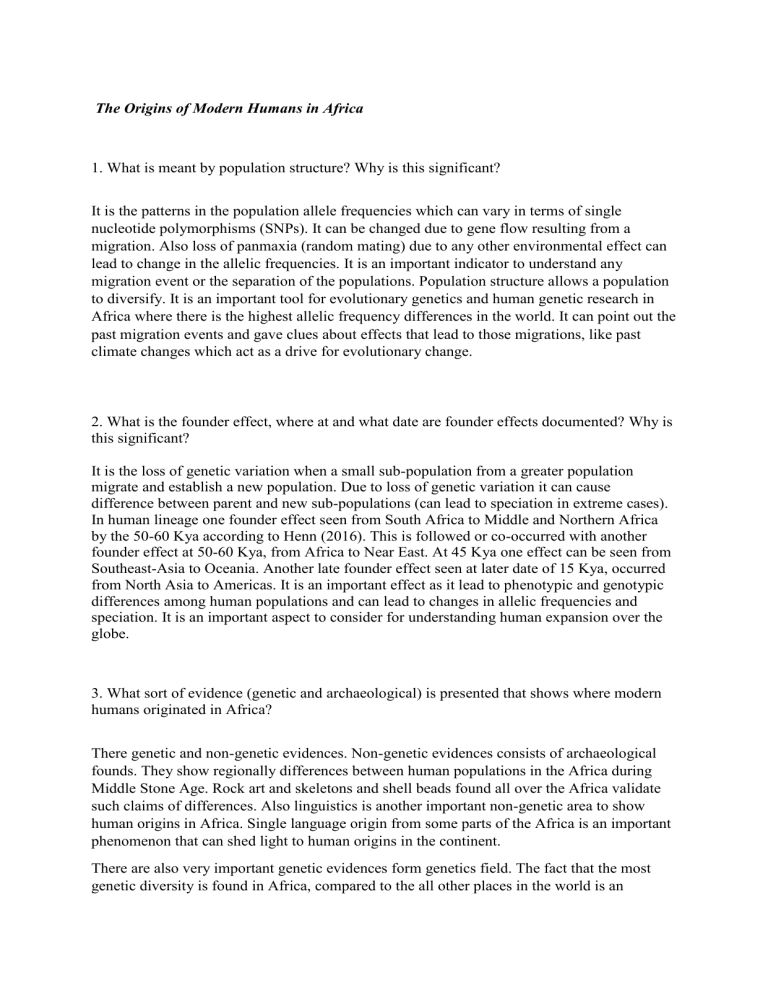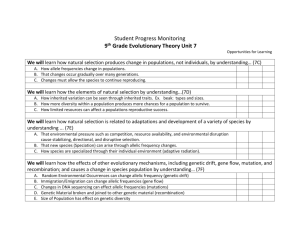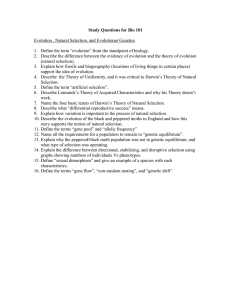
The Origins of Modern Humans in Africa 1. What is meant by population structure? Why is this significant? It is the patterns in the population allele frequencies which can vary in terms of single nucleotide polymorphisms (SNPs). It can be changed due to gene flow resulting from a migration. Also loss of panmaxia (random mating) due to any other environmental effect can lead to change in the allelic frequencies. It is an important indicator to understand any migration event or the separation of the populations. Population structure allows a population to diversify. It is an important tool for evolutionary genetics and human genetic research in Africa where there is the highest allelic frequency differences in the world. It can point out the past migration events and gave clues about effects that lead to those migrations, like past climate changes which act as a drive for evolutionary change. 2. What is the founder effect, where at and what date are founder effects documented? Why is this significant? It is the loss of genetic variation when a small sub-population from a greater population migrate and establish a new population. Due to loss of genetic variation it can cause difference between parent and new sub-populations (can lead to speciation in extreme cases). In human lineage one founder effect seen from South Africa to Middle and Northern Africa by the 50-60 Kya according to Henn (2016). This is followed or co-occurred with another founder effect at 50-60 Kya, from Africa to Near East. At 45 Kya one effect can be seen from Southeast-Asia to Oceania. Another late founder effect seen at later date of 15 Kya, occurred from North Asia to Americas. It is an important effect as it lead to phenotypic and genotypic differences among human populations and can lead to changes in allelic frequencies and speciation. It is an important aspect to consider for understanding human expansion over the globe. 3. What sort of evidence (genetic and archaeological) is presented that shows where modern humans originated in Africa? There genetic and non-genetic evidences. Non-genetic evidences consists of archaeological founds. They show regionally differences between human populations in the Africa during Middle Stone Age. Rock art and skeletons and shell beads found all over the Africa validate such claims of differences. Also linguistics is another important non-genetic area to show human origins in Africa. Single language origin from some parts of the Africa is an important phenomenon that can shed light to human origins in the continent. There are also very important genetic evidences form genetics field. The fact that the most genetic diversity is found in Africa, compared to the all other places in the world is an important indicator of Homo sapiens radiation out of Africa initially. Y-chromosome studies validates this higher genetic diversity in Africa. Also mitochondrial DNA studies gave out similar results. They are important genetic areas to study as they gave out maternal and paternal origins in human genome. Along with mtDNA and Y-chromosome studies, autosomal chromosome studies yields important results. SNPs and microsatellites (short sequences of nucleotides that repeats in unique patterns in the genome). All this genetics indicators along with the phenomenon of population structure, allelic frequencies and gene flow, shows a great deal of evidence to say that modern humans originated from the African continent. Henn suggest that a simple single origin model is plausible and says South Africa as the origin point for human lineage.




